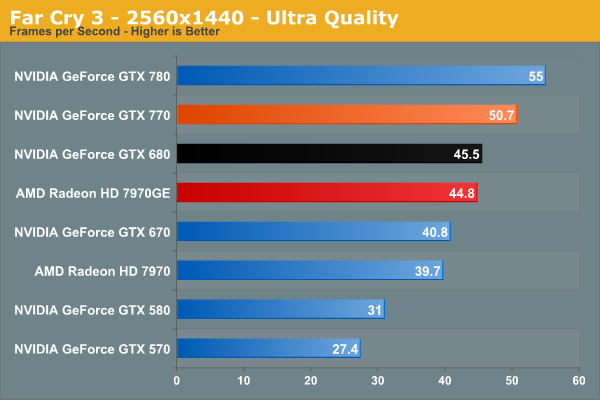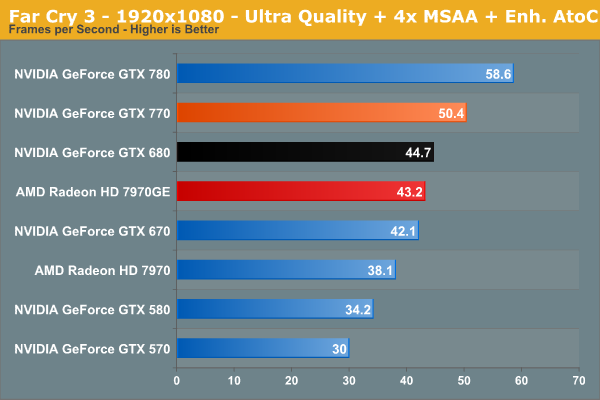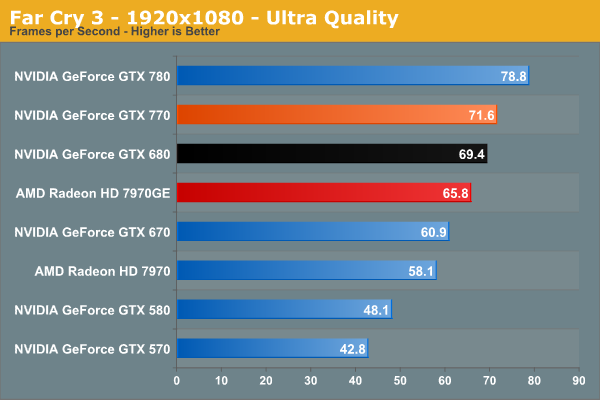NVIDIA GeForce GTX 770 Review: The $400 Fight
by Ryan Smith on May 30, 2013 9:00 AM ESTFar Cry 3
The next game in our benchmark suite is Far Cry 3, Ubisoft’s island-jungle action game. A lot like our other jungle game Crysis, Far Cry 3 can be quite tough on GPUs, especially with MSAA and improved alpha-to-coverage checking thrown into the mix. On the other hand it’s still a bit of a pig on the CPU side, and seemingly inexplicably we’ve found that it doesn’t play well with HyperThreading on our testbed, making this the only game we’ve ever had to disable HT for to maximize our framerates.



With Far Cry 3 we shift to a set of games that historically favor NVIDIA’s cards, and as it turns out benefit the GTX 770 to a pretty big degree. At 2560 we’re looking at a 13% advantage over the 7970GE, rising to 17% at 1920 without MSAA. The GTX 680 and GTX 570 are also summarily put in their place, with the GTX 770 gaining on them by 11% and 85% respectively.










117 Comments
View All Comments
chizow - Thursday, May 30, 2013 - link
They are both overpriced relative to their historical cost/pricing, as a result you see Nvidia has posted record margins last quarter, and will probably do similarly well again.Razorbak86 - Thursday, May 30, 2013 - link
Cool! I'm both a customer and a shareholder, but my shares are worth a hell of a lot more than my SLi cards. :)antef - Thursday, May 30, 2013 - link
I'm not happy that NVIDIA threw power efficiency to the wind this generation. What is with these GPU manufacturers that they can't seem to CONSISTENTLY focus on power efficiency? It's always...."Oh don't worry, next gen will be better we promise," then it finally does get better, then next gen sucks, then again it's "don't worry, next gen we'll get power consumption down, we mean it this time." How about CONTINUING to focus on it? Imagine any other product segment where a 35%! power increase would be considered acceptable, there is none. That makes a 10 or whatever FPS jump not impressive in the slightest. I have a 660 Ti which I feel has an amazing speed to power efficiency ratio, looks like this generation definitely needs to be sat out.jwcalla - Thursday, May 30, 2013 - link
It's going to be hard to get a performance increase without sacrificing some power while using the same architecture. You pretty much need a new architecture to get both.jasonelmore - Thursday, May 30, 2013 - link
or a die shrinkBlibbax - Thursday, May 30, 2013 - link
As these cards have configurable TDP, you get to choose your own priorities.coldpower27 - Thursday, May 30, 2013 - link
There isn't much you can really do when your working with the same process node and same architecture, the best you can hope for is a slight bump in efficiency at the same performance level but if you increase performance past the sweet spot, you sacrifice efficiency.In past generation you had half node shrinks. GTX 280 -> GTX 285 65nm to 55nm and hence reduced power consumption.
Now we don't, we have jumped straight from 55nm -> 40nm -> 28nm, with the next 20nm node still aways out. There just isn't very much you can do right now for performance.
JDG1980 - Thursday, May 30, 2013 - link
Yes, this is really TSMC's fault. They've been sitting on their ass for too long.tynopik - Thursday, May 30, 2013 - link
maybe a shade of NVIDIA green for the 770 in the charts instead of AMD red?joel4565 - Thursday, May 30, 2013 - link
Looks like an interesting part. If for no other reason that to put pressure on AMD's 7950 Ghz card. I imagine that card will be dropping to 400ish very soon.I am not sure what card to pick up this summer. I want to buy my first 2560x1440 monitor (leaning towards Dell 2713hm) this summer, but that means I need a new video card too as my AMD 6950 is not going to have the muscle for 1440p. It looks like both the Nvida 770 and AMD 7950 Ghz are borderline for 1440p depending on the game, but there is a big price jump to go to the Nvidia 780.
I am also not a huge fan of crossfire/sli although I do have a compatible motherboard. Also to preempt the 2560/1440 vs 2560/1600 debate, yes i would of course prefer more pixels, but most of the 2560x1600 monitors I have seen are wide gamut which I don't need and cost 300-400 more. 160 vertical pixels are not worth 300-400 bucks and dealing with the Wide gamut issues for programs that aren't compatible.